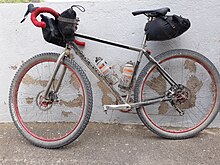Gravel bike
Gravel bikes (German for "Schotter-Rad") are all -terrain bikes that were formerly known as cross -country bikes . Today, slightly wider tires (28 inches, width approx. 35–47 millimeters) are used; in the past, the larger tubular tires with 27 inches and widths of up to 35 millimeters were common.
history
From around 2015, various manufacturers introduced bicycles in their programs under the designation "Gravel-Bike". Initially introduced in the US market, this name is also becoming increasingly popular in Europe. Such bicycles have been popular in Europe since the early 1960s under the name of cyclo-cross bikes.
concept
The genus of gravel bikes is a marketing term used by bicycle manufacturers; this type of bike was previously advertised in the USA and the UK in part under the name "Adventure Bikes". The distinction between endurance bikes and cyclocross bikes is also unclear. The aim of the development was to build a bike that could not only be used on normal roads but also on unpaved roads. A gravel bike in the narrower sense is a bike for comfortable and fast driving on gravel and gravel.
The bikes are suitable for racing or cycling (RTF) on gravel paths. The online publication Rennrad News lists some of the characteristics of a gravel bike (expanded here by a few points):
- Developed for long journeys on paved but unpaved roads.
- Equipped with racing bike handlebars and groupsets known from the racing bike sector. The lower link is often issued ("flare") for more comfort and control off-road.
- Disc brakes (hydraulically / partially hydraulically operated) with a diameter of 160 mm.
- Robust design with a slightly lower focus on weight reduction, frame made of carbon fiber reinforced plastic or light aluminum construction, more rarely steel or titanium.
- 28 inch wheels. Usually for tires up to 47 mm without mudguards - the same as with cyclocross.
- Sometimes 1x10, 1x11 or 1x12-fold switching systems and corresponding cassettes with large transmission ranges are used.
- The bicycles should also serve as everyday bikes.
- A more upright sitting position (less than 90 degrees hands to the upper body) to relieve the hands over long distances.
- A very deep bottom bracket, for more stability in rougher terrain, similar to 26 ″ mountain bikes.
- Longer wheelbase than cyclocross wheels, so good straight-line stability, and thanks to a long rear end, good properties when climbing steep passages.
- More caster on the fork than on racing bikes, so better straight-line stability.
- Eyelets on the frame and fork to attach mudguards, bags and, on some models, luggage racks.
Sports
The races for gravel bikes are often called gravel grinders . The most famous race for gravel bikes in the USA is the Dirty Kanza . The race is approximately 322 km (200 miles) over gravel roads. Another racing series that takes place internationally at various locations is the Grinduro .
Web links
Individual evidence
- ↑ Gravel bike - what is it and why do you need it? In: Roadcycling.de. Retrieved October 17, 2017 .
- ↑ a b The difference between a gravel bike, cyclocross bike and all-road racing bike. In: Rennrad-News.de. November 20, 2017. Retrieved November 22, 2017 .
- ↑ gravel bike guide .
